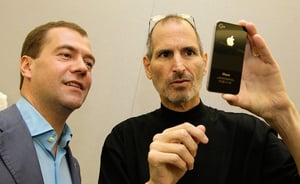 Steve Jobs, the late founder and CEO of Apple, is known around the world as one of the great thought leaders of our time. He didn’t create Apple in a vacuum, though. A lot happened between the time that Jobs was building computers in a garage with Steve Wozniak and when he became known for his black turtlenecks and amazing innovations in smartphone and tablet technology.
Steve Jobs, the late founder and CEO of Apple, is known around the world as one of the great thought leaders of our time. He didn’t create Apple in a vacuum, though. A lot happened between the time that Jobs was building computers in a garage with Steve Wozniak and when he became known for his black turtlenecks and amazing innovations in smartphone and tablet technology.
While Jobs may have been considered a genius in the tech industry, his success is attributable to more than just his intelligence. It also came from a desire and drive to answer questions and solve problems. In this way, Steve Jobs can teach us a lot about how we teach STEM curriculum to students.
1. Solving Problems is More Engaging Than Memorizing Facts
Every innovation that Steve Jobs made over his career, whether through his own work or through the potential he saw in others, came from recognizing a problem as an opportunity and searching for a way to solve it. Inquiry-based learning is entirely modeled on this kind of scenario. Rather than having children read textbooks filled with facts, inquiry-based learning gives them the opportunity to approach questions and problems, developing problem-solving skills instead of memorizing facts and figures.
2. There’s Always Room for Innovation
Jobs’ entire career was based on inquiry and exploration. In fact, his approach to computing and innovation can easily be summed up in Apple’s marketing campaign from the late ‘90s: Think Different. Jobs was constantly pushing the envelope and looking for new ways to solve old problems better. There’s room for creativity, and there’s almost always more than one "right" answer when it comes to solving problems and innovating.
3. Inquiry-Based Learning Lets You Create a Bicycle for the Mind
When discussing why he’d chosen computing, Jobs once called the computer a "bicycle for the mind," in reference to a diagram he once saw showing how fast animals travel. Basically, humans are some of the slowest animals on Earth. However, through engineering we can create a bicycle, and when you put one of us on a bicycle you suddenly have an animal that can outpace most other species. Jobs looked at computers as the leg-up we needed for more efficient thought and productivity.
Jobs set out in all of his endeavors to create tools and solutions that took human capabilities even farther. His innovations came about through inquiry, exploration, and creative problem-solving. When students are encouraged to ask questions and constantly explore new possibilities the way Jobs did, great things can happen in the classroom and beyond.
4. Every Day is an Opportunity to Learn
"When I was seventeen, I read a quote that went something like, 'If you live each day as if it was your last, some day you’ll most certainly be right.' It made an impression on me, and since then, for the past 33 years, I have looked in the mirror every morning and asked myself, 'If today were the last day of my life, would I want to do what I am about to do today?' And whenever the answer has been, 'No,' for too many days in a row, I know I need to change something." —Steve Jobs
Steve Jobs approached his life from a basis of inquiry, evaluation, and exploration. If we teach our students to do the same, they’ll be set for life to analyze personal and professional situations, innovate in their careers and their relationships, and create a better tomorrow.
Interested in building a better tomorrow for your students? Check out KnowAtom’s STEM curriculum. Learn how to bring the most innovative and effective teaching methods to your classroom today.
Image Source: Wikipedia via kremlin.ru

